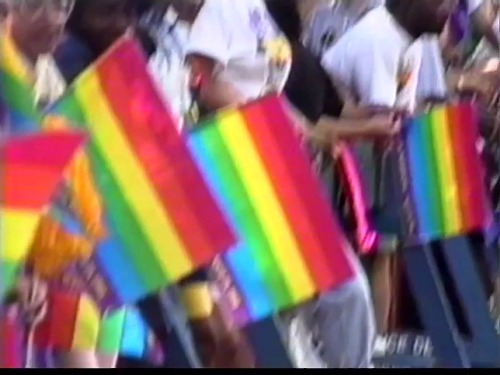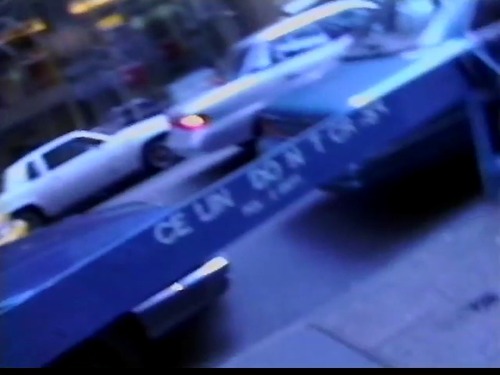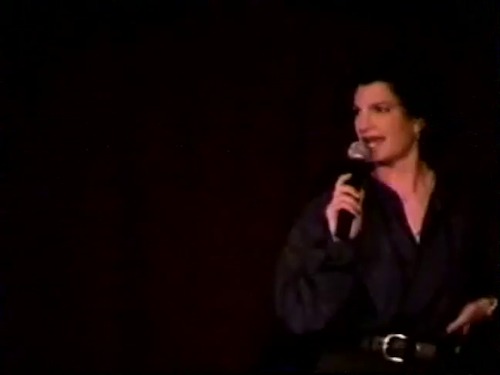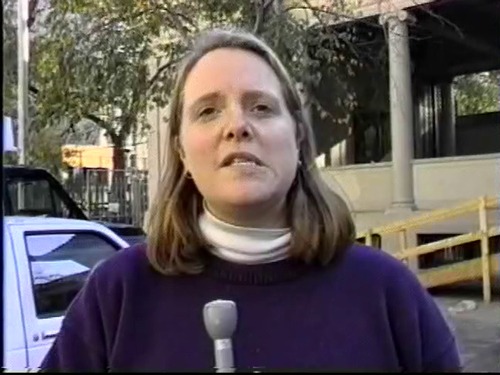
Browse Items (33 total)
Sort by:
-
Lesbians in the 1970s Civil Rights Movement
Marcia Danub and Linda Daniels speak with Eleanor Cooper, spokeswoman for Lesbian Feminist Liberation, and Jean O'Leary, Legislative Coordinator, Board for the (then) National Gay Taskforce. LGBTQ+ and women’s rights activists were looking to repeal laws criminalizing homosexuality. Sodomy bills in the 1970s were explicitly written to target gay people, causing fear in the LGBTQ+ in their professional and personal lives. Intro 554 was one of many forms of the NYC Gay Rights Bill, which was passed in 1986, banning discrimination because of sexual orientation. Cooper and O'Leary provide information about the way these laws affect the lives of lesbians and how to participate in the repeal of sodomy laws and support the passing of Intro 554. -
Jill Johnson on Lesbians in the Women's Movement
Columnist for the village voice, feminist, Jill Johnson discusses the role of the feminist lesbian within the larger movement of women’s liberation. Johnson discusses the variations in the NYC lesbian experience, and the relationship they have with straight women, and the overarching culture at large. She discusses the contributions that a lesbian feminist can make to empower other women. -
Neighborhood Voices: Irving Cooperberg [Partial interview]
Irving Cooperberg discusses the importance of having a physical, experimental space and what it means for the legitimacy and stability of the community. He discusses different LGBT groups and community spaces throughout NYC, and the ways in which they promote life and hope amidst the HIV/AIDs epidemic. He talks about how these spaces give legitimacy to the community and allow for the melding of all different cultures and people. He also discusses the gay Synagogue and its role in the larger gay and lesbian community. -
Neighborhood Voices: Sonny Wainwright Interview (Tape 3)
The New York gay bar scene in the 1950s gave Sonny Wainwright and her peers a place to be together without the interference of straight society. She left New York in 1953 to become a college teacher at University of New Hampshire. Wainwright oscillates between ideas of identity and stories of different instances of being outed in her personal and professional life, including a story about developing a relationship with a student at the University of New Hampshire, who outed her sexualty leading to her dismissal. -
Neighborhood Voices: Sonny Wainwright Interview (Tape 1)
Sonny Wainwright discusses coming out in 1948, navigating the Village bar scene as a young college student with her lover Kelly, and the social life of lesbians in the 1950s. Wainwright found support in the bars as well as her close circle of closeted friends prior to the formation of the Gay Women’s Alternative. -
Neighborhood Voices: Audre Lorde Interview (Tape 4)
In the final part of the Old Neighborhood Voices interview with Audre Lorde, she wraps up the talk with a discussion on the drama of lesbian life in her youth. She talks about the difficulties and joys of living in community with lesbians in the 1950s and how being on the edge of society gives you a different worldview. She stresses how everyone should view themselves as an outsider so they don't lose perspective on the true sense of power structures at play in the world. -
Neighborhood Voices: Audre Lorde Interview (Tape 3)
In the third part of the interview, Audre Lorde discusses the lure of the Village for gay people, black people, and others who wished for an egalitarian environment, and how sometimes they would ignore the homophobia and racism they faced in the neighborhood to hold onto this dream. Also, she discussed in more depth what she thought about the Stonewall riot, and how it felt tied to the black revolutionary movement of the time. Furthermore, she discusses at length the different gay bars she would frequent, their ties to the mafia, and the different women that would frequent them. -
Neighborhood Voices: Audre Lorde Interview (Tape 2)
In the second part of the Old Neighborhood Voices interview with Audre Lorde, she talks about living around the Village in the 1950s - from the migrators who came into the gay bars just for the weekend, to the imagined mythos of the Village as a place for anyone outside of white, middle-class America, and to the conflicts between the older residents and the newcomers to the area. Lorde touches on what her apartments were like and the rent situation of the area, as well as scrouging together food to share with her communities as a poor person. Then, Lorde discusses the multiple lives lesbians of the time had to live and the incredible gift that integrating every aspect of herself was as she got older. She touches on the Stonewall Riot, as well as the way she had to stop arbitrarily dividing aspects of herself to make others more comfortable. -
Neighborhood Voices: Audre Lorde Interview (Tape 1)
Old Neighborhood Voices interviews Audre Lorde about living as a young Black lesbian in the Lower East Side (now referred to as the East Village). She discusses the interconnectedness of the lesbian communities in the neighborhood, the imperfect support systems they offered each other when there were no other options, and the pressures of living on the edge of society. Lorde also discusses the racism that was rampant in the gay community in the Village, and how the few black lesbians within these communities were met with apathy when discussing political matters. She also discusses the effects of McCarthyism in the 1950s on her lesbian communities, as well as how she gained political consciousness growing up with the Brown v. Board of Education case, as well as by living near the Women’s House of Detention in the Lower East Side and seeing Black incarcerated women for the first time. -
Gay Pride Parade New York City, 1993 (Part 2)
Raw footage of the the Gay Pride Parade in New York City near Washington Square Park. Includes shots of spectators and parade participants including the Gay Police Association, RuPaul, Love Lounge, New Jersey Lesbian Coalition, The Eulenspiegel Society, Parents and Friends of Lesbians and Gays Long Island, Senior Action in a Gay Environment (SAGE), the Hetrick-Martin Institute, People With AIDS Coalition (PWAC) and PWAC Mother's Support Group, AIDS Resource Center, Community Health Project, The Village AIDS Programs, and Gay Men's Health Crisis. "Boycott Colorado" signs are present throughout, referencing Colorado's 1992 ballot Amendment 2 that prevented protected status under the law for homosexuals or bisexuals. -
Don't Ask Don't Tell Protest Footage
This video is documentation of a demonstration protesting Don’t Ask Don’t Tell. The protest occurred on September 23, 1993 outside a fundraiser for the then prospective mayor of New York David Dinkins in which Bill Clinton was speaking. This segment combines raw footage artifacts with more formal documentation of the chants, and informal interviews with the participants. The last portion of this video shows police attempting to forcibly remove demonstrators. -
Georgia Ragsdale Interview
This video features comedian Georgia Ragsdale. The video includes clips from an interview and stand up footage from one of Ragsdale’s performances. She discusses the way she approaches her work and being out as a comedian. Ragsdale explains that for her, “Being out as a comic isn't a choice, because as a stand up comedian all you have is your worldview, your perspective on life and your life and the people around you, so I don’t see how you have a choice to be in or out if you're a stand up comedian.” She also reminisces about her first hour long show when circumstances forced her to come up with enough material in a very short period of time.
-
Discrimination at Clark's Corner Restaurant
A woman reports about discrimination and threats she and her girlfriend faced when they kissed at a restaurant in Brooklyn Heights. She talks about the “kiss in” she and the Lesbian Avengers were having restaurant in protest. She also talks about plans to file a police report and take legal action if possible. -
Gay Pride Parade New York City, 1993 (Part 1)
This clip shows archival footage of the New York City Gay Pride Parade on June 27, 1993. This particular parade represented the 25th anniversary of the Stonewall Riots. It was also taking place at an apex for the movement against Don’t Ask Don’t Tell, banning out gay people from military service. Participating groups include the Lesbian and Gay Big Apple Corps, the Lesbian Avengers, the Women's Action Coalition, the Gay Veterans Association, and the Lesbian Herstory Archives. Also seen marching is politician Ruth Messinger and comedian/performer Lea DeLaria. -
Pamela Oline Interview, [date unknown]
Pamela Oline is interviewed. She is heterosexual and talks about her path to and experience of being a member of DOB and campaigning for gay and lesbian rights. She describes her childhood growing up in England, moving to America when she was 14 and changing career from a mathematician and to a psychotherapist. Recognizing the psychological issues of the time, she decided to understand the lesbian community from the inside. She talks about DOB meetings, lesbian and feminism issues, radical and conventional activism, marriage, and GAU (Gay Academic Union) meetings, panel discussions, etc.
Accompanied by an edited collection of clips, featuring Oline talking about being a Lesbian, the DOB and its eventual fractioning, and the debate of whether the lesbian's movement should be separate from the women's movement. -
Martha Shelley Interview, June 24, 1989
Martha Shelley is interviewed in New York in 1989. She talks about being a lesbian in New York from the 1960s, the negative views of lesbians portrayed by psychologists, the bar scene, roles and her use of a pseudonym. She talks about finding DOB, the meetings and discussions that took place, and her contributions to the Ladder. She talks about Jean Powers and other members of DOB and describes the members as mixed race, working class, couples and singles. She also talks about her political activism in terms of DOB, peace, civil rights and the Stonewall Riots, including the marches she was involved in and the speeches she made. -
Marilyn Lamkay Interview, April 8, 1987
Marliyn Lamkay is interviewed in New York City in 1987 (it seems to continue from a previous video and is perhaps continued in another video). She talks about being a lesbian in New York and coming out to her family and professionally, her relationships and religious beliefs. She discusses lesbian roles and how she didn't fit into any of the existing roles, even in the DOB community. She discusses community building and CR groups when she was younger and how she went on to hold workshops about resources for gay and lesbian New Yorkers at Bronx Community College. She mentions New YorkDOB meetings and the influence that DOB had in the creation of subsequent lesbian groups and communities. -
Barbara Emmerth Interview, February 21, 1988
Barbara Emmerth is interviewed in New York City in 1988. She discusses the uniqueness of coming out on West Virginia in the 1950s where there was little stigma attached to homosexuality because there was so little understanding or awareness of it. She speaks about her relationships, moving to New York City in the 1960s and her involvement with DOB (including a brief stint as the VP of the New York chapter) and with SAGE (Services & Advocacy for Gay, Lesbian, Bisexual & Transgender Elders). -
Alma Routsong Interview, January 20, 1990
Alma Routsong is interviewed in New York in 1990. She discusses her early experiences of being a lesbian and coming out. She explains how lesbian literature of the time informed her about DOB and influenced her to leave her husband and move to New York with her lover. Alma also discusses her writing career and use of a pseudonym. In tape 2 she discusses DOB groups and events, as well as the demise of DOB. -
For Toby by Shirley, Side A
This audio recording discusses the Daughters Of Bilitis New York City chapter. The main voice on the recording is a woman who was elected national president. She talks about her time as national president during the start of the Womens Rights movement. The recording discusses the success of the New York City Chapter and the new role they were playing in the Womens Rights movement. -
Mabel Hampton Interview [1920s / World War II]
Side A: Mabel Hampton describes meeting other lesbians and associating with other women "in the life". Also discussed is her experience during the 1920s of being set up and sentenced to serve three years for a fabricated prostitution charge at the Bedford Hills Correctional Facility for Women. Side B: Mabel's WWII era activities, including being an Air Raid Warden in Harlem, and meeting married women who ""came out"" during their husband's absence due to the war." -
Mabel Hampton, 1988 (Tape 1)
Mabel discusses her early life as a lesbian in the Village between the two world wars, including the rooming house where she lived and the parties she attended. She describes how women dressed, what they ate at the parties, what they did at the parties, including dancing, the records they listened to, and the general social life of these parties. She describes the interracial relations between white and black lesbians. She also discusses the language lesbians used to describe themselves at the time, including "bulldaggers", "lady lovers", and "butches". She also tells the story of a large lesbian marriage ceremony in Central Park West, officated by a gay minister named Rev. Monroe and how the couple managed to get an offical marriage certificate. She also discusses gay life in Harlem and the New York City drag balls. -
Mabel Hampton, November 28, 1986 (Tape 1)
Mabel talks about her life at theater Lafayette on Coney Island in the 20s. She also talks about the dress code of her and her friends; also the language describing lesbians back in the 1920s. -
Mabel Hampton Interview [Coney Island / Mildred]
Oral history interview of Mabel Hampton. Side A: Mabel discusses Coney Island, and her relationships with women, including Mildred Mitchell. -
Mabel Hampton Interview [The Twenties and Life With Lillian]
Oral history interview of Mabel Hampton. Mabel Hampton reminisces about her life in the early 1920s. Mabel talks about going to Coney Island, cabarets, and various parties around New York City where women could meet other women. She discusses her friends and relationships with particular emphasis on Lillian Foster. -
Mabel Hampton Singing and Talking
Oral history interview with Mabel Hampton. Side A: Mabel sings and talks about her life with Lillian Foster, and stories from her youth. Side B: She describes her life in Jersey City, Coney Island and the rape by her uncle. She also talks about the pitfalls of falling in love, and being a working woman at 80 years old. -
Mabel Hampton Interview [Coming out / Lillian]
Oral history interview of Mabel Hampton. Mabel talks about her childhood; coming out with a woman she met at Coney Island; her relationship with Lillian Foster; the LHA and her respect for Joan Nestle and Deborah Edel. -
Mabel Hampton's Story, July, 1986
Oral history interview of Mabel Hampton. Mabel describes running away from home and the New Jersey family who cared for her, while they sought Mabel's family. Mabel falsified her personal information in order to avoid reuniting with her abusive uncle in New York. Mabel speaks of her early 20s, her interaction within the underground gay and lesbian community. She begins explaining her 1923 arrest at Bedford Hills Prison and how she was setup by her friend's husband for prostitution. Side A = 9:38 minutes -
Mabel Hampton July, 1986
Oral History interview of Mabel Hampton. Mabel discusses her early life in South Carolina and New York. -
Mabel Hampton Interview [Marriage / Jealousy]
Oral history interview of Mabel Hampton. Mabel discusses lesbian marriage in the 1930s and 1940s, including stories of women getting married and where the ceremonies were. She tells stories about women she knew who had husbands and families, jealousy among women, and passion. She talks about her own experiences with passion and jealousy, including her crushes and relationships. She discusses her first relationship with a white woman, women she had crushes on, women she felt threatened by, her relationship with Lillian, and an experience at a "party house" in Bedford Hills. At the end of the tape there is a discussion about Lillian's tombstone and what to put on it. -
Mabel Hampton Interview [Stories of Performing / Singing]
Oral history interview of Mabel Hampton. Mabel discusses meeting her partner Lillian Foster in 1932, whom she was with for 40 years until her passing in 1979. Mabel also mentions highlights of her professional career including performing at the World's Fair (perhaps 1939 World's Fair in New York), Carnegie Hall and Coney Island. Mabel also recounts a story involving an incident with a classmate in her youth. The tape finishes with a rendition of "My Buddy", sung by an unidentified vocalist and pianist -
Mabel Hampton Interview [New Jersey / Singing]
Oral history interview of Mabel Hampton. Side A: Mabel tells the story of her arrival in New Jersey, and how she found the people who first took her there. Side B: Mabel sings the American popular song, "My Buddy", and also explains how she left her uncle in New York and went to New Jersey. She talks in detail about the first couple days that she spent in a home in Jersey City, and her reticence to discuss details about her origins with the people that took her in. Additional discussion includes a description of the first time she was kissed by a woman, and why she didn't pursue relationships with married women. -
Mabel Hampton for Feminary / Mabel Hampton; Joan Nestle, 1979 (Tape 1)
Oral history interview for Feminary: A Lesbian-Feminist Journal for the South. Joan Nestle interviews Mabel Hampton at 77. Mabel describes her childhood in Winston-Salem, North Carolina, her train journey to New York City, the city vs. the country, meeting lesbians and her views on race, sisterhood and the fight for lesbian rights.



















![[2014SP]ForTobybyShirleyloSideA.mp3 [2014SP]ForTobybyShirleyloSideA.mp3](/omeka/application/views/scripts/images/fallback-audio.png)












